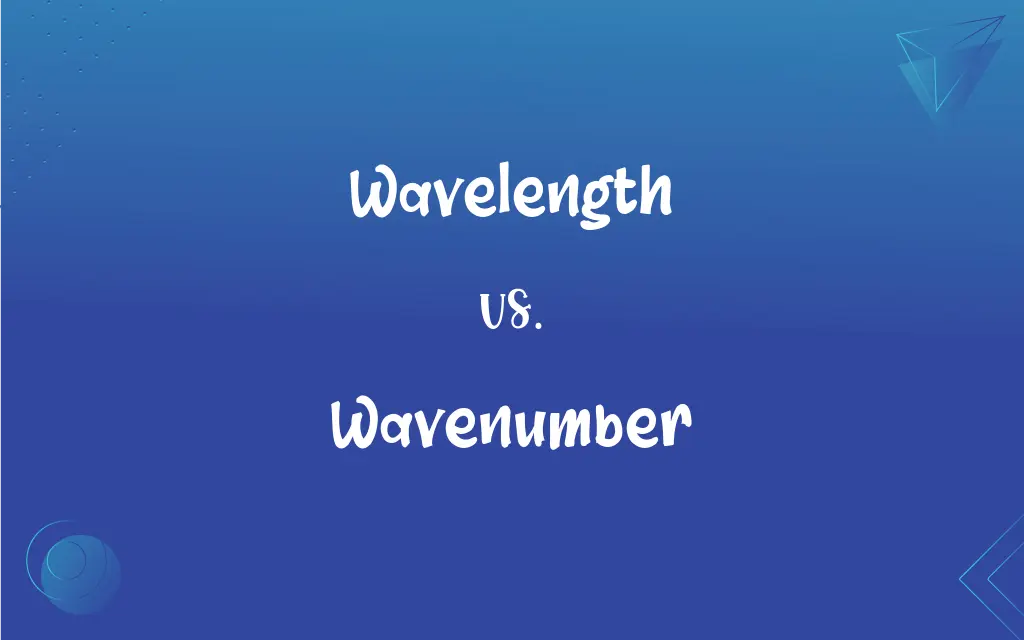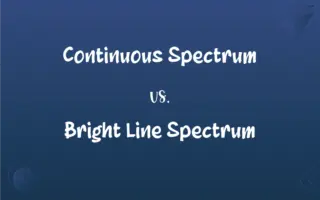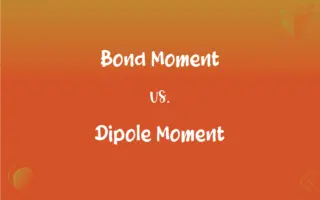Wavelength vs. Wavenumber: What's the Difference?
Edited by Aimie Carlson || By Janet White || Published on January 22, 2024
Wavelength is the distance between successive crests of a wave. Wavenumber is the number of wave cycles per unit distance, typically measured in inverse meters.

Key Differences
Wavelength refers to the physical length of one cycle of a wave, typically measured from crest to crest or trough to trough. In contrast, wavenumber quantifies the number of wave cycles in a unit distance, essentially representing the spatial frequency of the wave.
The wavelength is inversely proportional to frequency, meaning higher frequency waves have shorter wavelengths. Conversely, wavenumber directly correlates with frequency, as more wave cycles per unit length correspond to higher frequencies.
In terms of units, wavelength is usually measured in meters (m), micrometers (μm), or nanometers (nm), depending on the wave's size. Wavenumber, on the other hand, is typically expressed in inverse meters (m⁻¹), highlighting the number of wave cycles per meter.
Wavelength is a more intuitive measure for visualizing the size and scale of waves, especially in optics and electromagnetism. Wavenumber offers a more analytical approach, often used in spectroscopy and quantum mechanics to describe wave properties.
The wavelength is significant in applications like fiber optics, where light's physical length impacts transmission, while wavenumber is crucial in spectroscopic analysis, helping identify substances based on wave frequency characteristics.
ADVERTISEMENT
Comparison Chart
Definition
Distance between successive wave crests
Number of wave cycles per unit distance
Units
Meters (m), micrometers (μm), nanometers (nm)
Inverse meters (m⁻¹)
Relation to Frequency
Inversely proportional
Directly proportional
Common Applications
Optics, Electromagnetism
Spectroscopy, Quantum Mechanics
Measurement Interpretation
Measures wave size and scale
Measures spatial frequency
ADVERTISEMENT
Wavelength and Wavenumber Definitions
Wavelength
The distance between successive peaks of a wave.
The wavelength of red light is longer than that of blue light.
Wavenumber
A parameter in wave equations representing spatial periodicity.
The wavenumber in physics equations helps calculate wave properties.
Wavelength
The distance over which a wave's shape repeats.
Fiber optics technology utilizes the wavelength of light for efficient data transmission.
Wavenumber
The inverse of wavelength, representing wave cycles per meter.
In quantum mechanics, the wavenumber is used to describe particle wavelengths.
Wavelength
The physical length from one point on a wave to the same point on the next cycle.
The wavelength of visible light ranges from 400 to 700 nanometers.
Wavenumber
The number of complete wave cycles in a unit distance.
Higher wavenumber values indicate shorter, more frequent wave cycles.
Wavelength
A key parameter in wave physics, denoting wave size.
The wavelength of sound waves affects the pitch we hear.
Wavenumber
A measure of spatial frequency, often used in spectroscopy.
Spectroscopists use wavenumber to identify chemical compounds.
Wavelength
A measure of the spatial length of a wave cycle.
In radio communications, wavelength determines the antenna size.
Wavenumber
A unit of measurement in inverse meters for wave analysis.
Infrared spectroscopy often measures molecular vibrations in terms of wavenumber.
Wavelength
The distance between one peak of a wave to the next corresponding peak, or between any two adjacent corresponding points, defined as the speed of a wave divided by its frequency.
Wavenumber
A measure of the number of waves in unit distance; inversely proportional to its wavelength.
Wavelength
(physics) The length of a single cycle of a wave, as measured by the distance between one peak or trough of a wave and the next; it is often designated in physics as λ, and corresponds to the velocity of the wave divided by its frequency.
Wavelength
(figurative) A person's attitude and way of thinking as compared to another person's.
I think you and I are on a different wavelength.
Wavelength
The distance (measured in the direction of propagation) between two points in the same phase in consecutive cycles of a wave
Wavelength
A shared orientation leading to mutual understanding;
They are on the same wavelength
FAQs
How is wavelength measured?
It's typically measured in meters, micrometers, or nanometers.
What is the relationship between wavelength and frequency?
Wavelength is inversely proportional to frequency.
Which is more commonly used in optics, wavelength or wavenumber?
Wavelength is more commonly used in optics.
Does wavelength affect sound?
Yes, it determines the pitch of the sound.
What is wavenumber?
It's the number of wave cycles per unit distance.
How is wavenumber measured?
It's measured in inverse meters (m⁻¹).
Are wavelength and wavenumber related?
Yes, wavenumber is the inverse of wavelength.
What is wavelength?
It's the distance between successive crests of a wave.
How do wavelength and wavenumber relate to light's color?
Wavelength corresponds to color perception, while wavenumber indicates color frequency.
What role does wavelength play in telecommunications?
It determines the frequency range and antenna design in communication systems.
How is wavenumber important in quantum mechanics?
It's used to describe the properties of particles and waves at a quantum level.
Can wavenumber help in identifying chemical structures?
Yes, through spectroscopic analysis of molecular vibrations.
What is the relationship between wavenumber and frequency?
Wavenumber is directly proportional to frequency.
Is wavelength significant in astronomy?
Yes, for analyzing celestial objects' light and radiation.
Can both wavelength and wavenumber be used in remote sensing?
Yes, they're important in analyzing data from satellite imagery and sensors.
Can wavelength be used to identify substances?
Yes, particularly in spectroscopy through light absorption patterns.
Is wavenumber used in spectroscopy?
Yes, it's a key measure for analyzing material properties.
How does wavelength impact fiber optics?
It affects the transmission and efficiency of light through optical fibers.
Is wavenumber relevant in acoustic engineering?
Yes, especially in analyzing sound wave patterns and frequencies.
What applications use wavenumber measurements?
Spectroscopy, quantum mechanics, and materials science.
About Author
Written by
Janet WhiteJanet White has been an esteemed writer and blogger for Difference Wiki. Holding a Master's degree in Science and Medical Journalism from the prestigious Boston University, she has consistently demonstrated her expertise and passion for her field. When she's not immersed in her work, Janet relishes her time exercising, delving into a good book, and cherishing moments with friends and family.
Edited by
Aimie CarlsonAimie Carlson, holding a master's degree in English literature, is a fervent English language enthusiast. She lends her writing talents to Difference Wiki, a prominent website that specializes in comparisons, offering readers insightful analyses that both captivate and inform.








































































